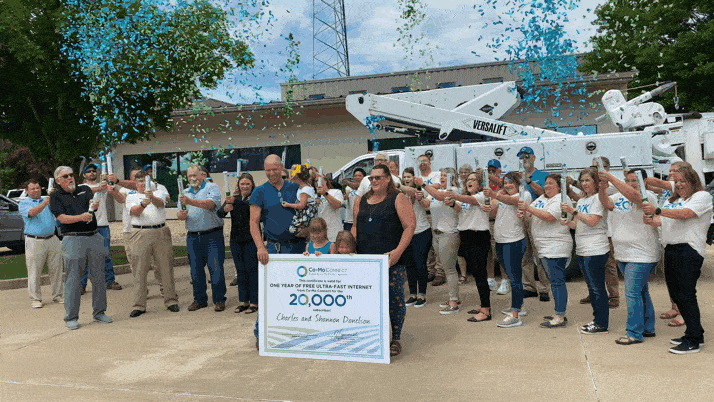Co-op Members
25,903
Total Miles of Fiber
4,229
Project Timeline
5 years
Unwilling to give up, Co-Mo’s team chose a different path.
Originally published: February, 2020
Serving Central Missouri communities desperate for internet service with broadband available in only 15% of the territory – the co-op applied for government funds in 2010 to build out a high-speed network. Despite the enthusiasm, letters and lobbying from co-op members, however, the funding didn’t happen.
Conexon Partner Randy Klindt, a member of the co-op’s broadband leadership team at the time, wrote a financial plan for Co-Mo to self-finance a gigabit fiber-to-the-home network – a virtually unheard-of financial model. No co-op had been able to build out broadband without government subsidizing. Co-Mo’s progressive Board of Directors agreed to a pilot, and if take rates were at least 25%, would support a full launch. In 2010, Co-Mo boldly launched a triple play pilot – offering not just Internet, but phone and TV as well.
Co-op members rallied behind the pilot, with some going door-to-door to convince friends and neighbors to subscribe, and in some cases paying the required $100 deposit for them. Two area banks even volunteered to pay the deposit for all their bank depositors. The pilot easily met the 25% threshold and Co-Mo Connect debuted as the co-op’s broadband subsidiary, charged with building out fiber to the home to serve 100% of Co-Mo’s members.
“Our Board was visionary, and willing to take a chance to build a network that would meet our members’ needs,” says Co-Mo CEO Aaron Bradshaw. “When we started building the network in 2012, we approached it in four phases with ‘off-ramps’ along the way so that if necessary, we could stop. Fortunately, that didn’t happen.”

And the rest is history!
The unique design and architecture driven by Klindt enabled Co-Mo to construct the network and build out to all members at a low overall construction cost, which made the project initially feasible, and then cash flow positive at an extremely accelerated rate. By 2015, just five years after the start of the project, Co-Mo Connect was cash flow positive. It became the first co-op to build out a fiber-to-the-home network to 100% of its co-op membership without federal grants or subsidies. And by mid-2017, Co-Mo had completed a fiber buildout that covered its entire territory and beyond.
“We didn’t stay exclusive to our territory when we built out,” Bradshaw explains. “We took on several other cities that were underserved or unserved. Our approach was not to compete on price, but really just demonstrate the quality of our product. Some of the competitors in the market would advertise speeds of 10Mbps down and 3Mbps up, but customers were usually lucky to get 3 down. It was easy to win when offering gigabit speed at a lower cost, and service backed by the co-op.”
Today Co-Mo Connect has more than 18,000 subscribers connected, and by the end of 2024, expects to have 32,000. Thanks to the broadband provided by Co-Mo Connect, professionals are now able to work at home, allowing them to be present with their children, while still maintaining their careers. Better healthcare is available to rural residents via telemedicine, made possible only with high-speed data. There are more job opportunities and the economy is improving. And thanks to Wi-Fi powered by Co-Mo Connect, Missouri’s Lake of the Ozarks Boy Scout Council boasts the nation’s only Scouting Invention Campus, a resource that provides them access to cutting-edge technology, engineering labs, 3D printing and more.
"Our Board was visionary and willing to take a chance to build a network that would meet our members’ needs,” says Co-Mo CEO Aaron Bradshaw. “When we started building the network in 2012, we approached it in four phases with ‘off-ramps’ along the way so that if necessary, we could stop. Fortunately, that didn’t happen.”

The Conexon influence
In 2018, Co-Mo Connect joined Conexon’s Rural Electric Cooperative Consortium (RECC), bidding for Connect America Fund (CAF) II broadband funds. Under the leadership and guidance of Conexon Partner Jonathan Chambers, the RECC was deemed the largest, most successful bidding consortium in FCC history. For its part, Co-Mo was awarded $22 million, funds that will help fuel its growth and expand even further out of territory.
“I was ecstatic after the auction. Thanks to Conexon, we were extremely successful,” says Bradshaw. “The CAF II funding has allowed us to expand our service to meet the needs of additional areas that otherwise would be underserved or unserved. And although we were always on target for a successful ROI, our timelines for that are shortened considerably with the CAF II funds.”
Over its years in operation, Co-Mo Connect has expanded its staff to meet the needs of its growing subscriber base. But given Klindt’s network design and initial project influence, and Chambers’ experience in the regulatory and funding arena, the co-op continues to leverage Conexon expertise.
“Conexon is a great partner and we count on them to fill in gaps where we may not have expertise or knowledge,” Bradshaw said. “The team comes from a background that gives them perspective and an understanding of the challenges in rural America.”
A bright future
Moving forward, Co-Mo Connect is all about growth – in four years, it will have as many subscribers as meters – and continuing to blaze new trails for other co-ops. Bradshaw’s advice?
“If you’re going to get into broadband, jump in with both feet,” he says. “Prepare your staff for some big changes and choose your partners wisely.
“The need is great and as soon as people know it’s coming, you’ll be bombarded, so be ready,” he adds laughing.